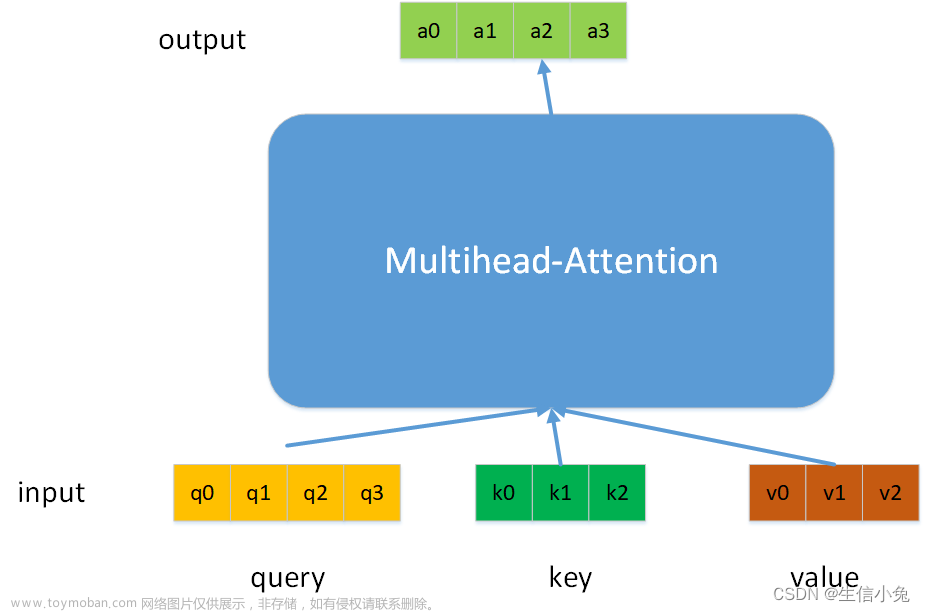
transformer的细节到底是怎么样的?Transformer 连环18问!
4.1 从功能角度,Transformer Encoder的核心作用是提取特征,也有使用Transformer Decoder来提取特征。例如,一个人学习跳舞,Encoder是看别人是如何跳舞的,Decoder是将学习到的经验和记忆,展现出来
4.2 从结构角度,如图5所示,Transformer Encoder = Embedding + Positional Embedding + N*(子Encoder block1 + 子Encoder block2);
子Encoder block1 = Multi head attention + ADD + Norm;
子Encoder block2 = Feed Forward + ADD + Norm;
4.3 从输入输出角度,N个Transformer Encoder block中的第一个Encoder block的输入为一组向量 X = (Embedding + Positional Embedding),向量维度通常为512*512,其他N个TransformerEncoder block的输入为上一个 Transformer Encoder block的输出,输出向量的维度也为512*512(输入输出大小相同)。
4.4 为什么是512*512?前者是指token的个数,如“我爱学习”是4个token,这里设置为512是为了囊括不同的序列长度,不够时padding。后者是指每一个token生成的向量维度,也就是每一个token使用一个序列长度为512的向量表示。人们常说,Transformer不能超过512,否则硬件很难支撑;其实512是指前者,也就是token的个数,因为每一个token要做self attention操作;但是后者的512不宜过大,否则计算起来也很慢。

5.1 从功能角度,相比于Transformer Encoder,Transformer Decoder更擅长做生成式任务,尤其对于自然语言处理问题。
5.2 从结构角度,如图6所示,Transformer Decoder = Embedding + Positional Embedding + N*(子Decoder block1 + 子Decoder block2 + 子Decoder block3)+ Linear + Softmax;
子Decoder block1 = Mask Multi head attention + ADD + Norm;
子Decoder block2 = Multi head attention + ADD + Norm;
子Decoder block3 = Feed Forward + ADD + Norm;
5.3 从(Embedding+Positional Embedding)(N个Decoder block)(Linear + softmax) 这三个每一个单独作用角度:
Embedding + Positional Embedding :以机器翻译为例,输入“Machine Learning”,输出“机器学习”;这里的Embedding是把“机器学习”也转化成向量的形式。
N个Decoder block:特征处理和传递过程。
Linear + softmax:softmax是预测下一个词出现的概率,如图7所示,前面的Linear层类似于分类网络(ResNet18)最后分类层前接的MLP层。

6. Transformer Encoder和Transformer
Decoder有哪些不同?
6.1 作用上,Transformer Encoder常用来提取特征,Transformer Decoder常用于生成式任务。Transformer Encoder和Transformer Decoder是两条不同的技术路线,Bert采用的前者,GPT系列模型采用的是后者。
6.2 结构上,Transformer Decoder block包括了3个子Decoder block,而Transformer Encoder block 包括2个子Encoder block,且Transformer Decoder中使用了Mask multi-head Attention。
6.3 从二者的输入输出角度,N个Transformer Encoder运算完成之后,它的输出才正式输入进Transformer Decoder,作为QKV中的K和V,给Transformer Decoder使用。那么TransformerEncoder最后层的输出是如何送给Decoder呢?
7. 什么是Embedding?
7.1 Embedding在Transformer架构中的位置如图13所示。
7.2 提出背景: 计算机无法直接处理一个单词或者一个汉字,需要把一个token转化成计算机可以识别的向量,这也就是embedding过程。
7.3 实现方式: 最简单的embedding操作就是one hot vector,但one hot vector有一个弊端就是没有考虑词语前后之间的关系,后来也就产生了WordEmbedding,如图13。
What is cross-attention, and how does it differ from self-attention?
In self-attention, we work with the same input sequence. In cross-attention, we mix or combine two different input sequences. In the case of the original transformer architecture above, that’s the sequence returned by the encoder module on the left and the input sequence being processed by the decoder part on the right.
Note that in cross-attention, the two input sequences \(\mathbf{x}_1\) and \(\mathbf{x}_2\) can have different numbers of elements. However, their embedding dimensions must match.
The figure below illustrates the concept of cross-attention. If we set \(\mathbf{x}_1 = \mathbf{x}_2\), this is equivalent to self-attention.

下面是Cross-Attention
 文章来源:https://www.toymoban.com/news/detail-564113.html
文章来源:https://www.toymoban.com/news/detail-564113.html
(Note that the queries usually come from the decoder, and the keys and values usually come from the encoder.)文章来源地址https://www.toymoban.com/news/detail-564113.html
到了这里,关于Self-Attention && Cross-Attention的文章就介绍完了。如果您还想了解更多内容,请在右上角搜索TOY模板网以前的文章或继续浏览下面的相关文章,希望大家以后多多支持TOY模板网!













